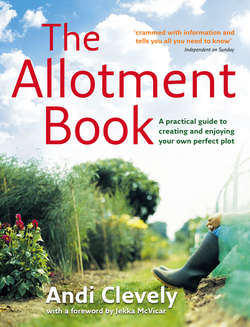Читать книгу The Allotment Book - Andi Clevely - Страница 43
RECYCLING SCAFFOLDING
ОглавлениеDiscarded scaffolding poles and their unions are a valuable resource for a host of structures on the plot. Use them, for example, to build fruit cages and low frames round brassica beds for netting against birds in winter; use them as row supports for runner beans or sweet peas and trained fruit like raspberries or tree-fruit cordons and espaliers; also for arches over paths, planted with squash, climbing cucumbers and thornless brambles.
Either fold back part of the side netting for access or add a hinged door, but make sure this fits tightly. The roof net can be removed after fruit crops are harvested to allow birds to clean up any pests, but leave it in place if finches tend to attack the fruit buds in winter. However, the roof should always be taken off if snow is forecast. Open the door or (where this is possible) roll up the sides while the fruit is flowering, to admit pollinating insects.
Somewhere to sit As in any other garden, an allotment plot should have a place for you to recover from hard work, entertain friends and other plot-holders, or just plan and dream. It doesn’t matter whether you choose to sit on an upturned bucket or a cast-off chaise longue, although comfort is obviously important.
Collapsible furniture such as picnic tables or deck chairs can be stored safely in a locked shed. Permanent structures like benches or café tables need to be secured by bolting them to the shed wall or anchoring them with metal straps to pegs or piles driven firmly into the ground. Treat your furniture to an annual spring clean: treat or paint metal with rust-proofing, and paint or oil timber pieces to keep rot and woodworm at bay.
